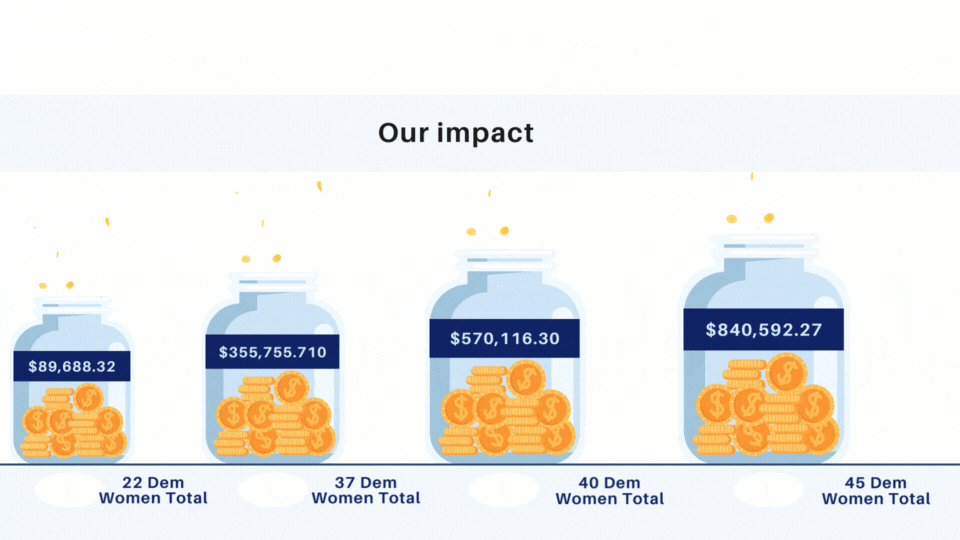The last breakfast briefing we had was a real eye-opener for me. It featured Dr. Kelly Dittmar from Rutgers University’s Center for American Women and Politics (CAWP). Dr. Dittmar talked about the Center’s research from two recent studies of women’s political power in this country. “The Donor Gap – Raising Women’s Political Voices” focused on women’s political donations to statewide elections (here’s the link) and the most recent study, “Rethinking Women’s Political Power” looked at women’s representation in state legislatures across several states, including Pennsylvania (here’s the link to that study).
Not surprisingly, the CAWP research shows that women as a group contribute less to political campaigns, and in smaller amounts, than men. At the briefing, we learned that donations from women for Pennsylvania state-level general elections (including the Governorship, Senate and House races, and state elected officials) in 2022 were 35% of all contributions. The number of individual donors was close to parity – 46% for women versus 54% for men – but on the whole, men made significantly larger donations.
How important is that statistic? I think it’s very important. Heidi Siegel, our communication director who facilitated the breakfast briefing said, pointing out that as donations to Represent PA increased over the years, women’s representation in our state’s legislature has increased as well (see the table below).

This is reflected in state rankings of women’s political representation: in 2010, Pennsylvania ranked a dismal 46 out of 50 states in the number of women elected to state legislatures. Today, Pennsylvania’s state ranking is 26. To me, it’s clear that Represent PA is a large part of that change. But there’s still more work to be done. As Heidi said at the briefing:
“…it makes me wonder: if we donated more to women candidates would more of them get elected?”
More donations are crucial, but we need other things as well if we want to increase women’s representation and power in state government. To learn what factors contributed to women’s political gains in recent years and what challenges women still face, the CAWP team interviewed roughly 200 “political influencers” across five different states, including Pennsylvania – current and past state legislators, political consultants, party staffers, lobbyists and industry leaders. The recent successes for women in the PA Legislature were attributed to a number of factors including:
- more training for new candidates by organizations like Emerge and Ready to Run;
- more role-models within state government as more women have taken on leadership positions; and
- the building of party structures outside the traditional ones in areas of the state where “the old-boy networks” often act as gatekeepers blocking the campaigns of newcomers, particularly women of color.
And it was great to see the responses from women legislators, like State Representative Donna Bullock and others, who credited the recent successes of women to Represent PA’s support, particularly in the early stages of their campaigns. For new women candidates in particular, the early money from Represent PA was credited with getting campaigns off the ground while also providing legitimacy to political influencers and potential donors in their districts.
The challenges for our candidates are still out there: the outdated belief by some in Pennsylvania that women are not as electable as men (which has been proven wrong!); the Democratic party strongholds outside Philly and Pittsburgh that are still tough to break into or go around when launching a campaign; and the lack of financial resources for many women who can’t afford to lose a salary and/or self-fund to run a successful campaign, to name a few.
What really resonated with me was CAWP’s finding that the states which have the most women elected to state offices (like Nevada and Colorado) seem to have the strongest and most established networks of women helping women. I believe we can do a better job of coalition-building in our state.
We’ve heard that it can be difficult to differentiate between Representative PA and other progressive women organizations like Emily’s List, Emerge, and Red Wine & Blue. Christine Jacobs, Represent PA’s Executive Director, has described the difference as “different lanes in the political landscape.” While Represent PA helps candidates with financial support, it doesn’t do candidate training or organize get-out-the-vote activities, for instance. We try to keep our donors up to date on what the other organizations are doing, particularly before elections. However, we can, and will, do more. We want women to realize the many ways they can use their power and influence. Watch the full briefing here.
– By Karen Gelman, Represent PA volunteer